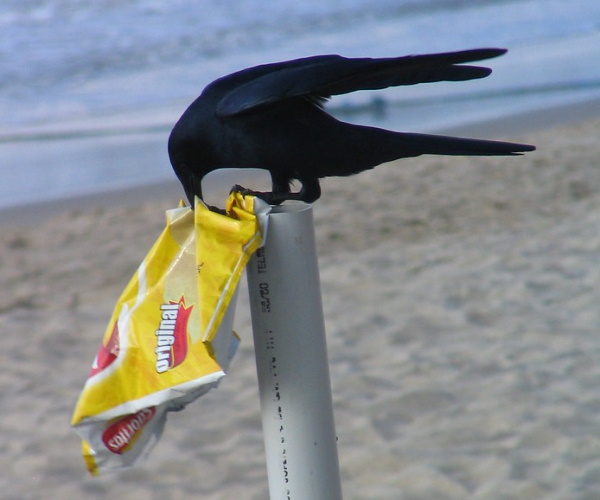Plastic Grocery Bags
They fly through the air and get snagged on tree branches. They float in the ocean, getting gobbled up by sea turtles who can’t tell their billowy forms from their usual (and digestible) fave snack, jellyfish. They’re plastic grocery bags, not single-use by any means but too often tossed, trashed and carelessly disposed of. ICC volunteers picked an astonishing 272,399 plastic grocery bags off the world’s beaches in 2020, saving uncounted numbers of jellyfish-eating marine creatures from a slow and agonizing demise. (image via Julian Stallabrass)
* Plastic Trash Fact: Lightweight plastic grocery bags are a luxury we can no longer afford, even taking into account the 5-cent-per bag surcharge imposed by 36 countries as of 2021. Kudos to the 88 other nations who have banned plastic grocery bags entirely, starting with Bangladesh in 2002. Dhaka ’bout being green!
Plastic Straws & Stirrers
Remember that poor sea turtle with a plastic straw stuck in its nose – and the grisly removal of such by some caring humans? That gut-wrenching scene convinced more than a few folks to ditch plastic straws, but in a good way. Five years later, we’ve still got a LONG way to go when it comes to disposable plastic straws and their sippin’ cousins, plastic coffee stirrers. Those hard-working ICC beach trash cleaners picked up 224,170 of them in 2020, a number that should leave you stirred AND shaken. (image via Anna Gregory)
* Plastic Trash Fact: Practical plastic straw alternatives have become widely available of late, and Eco-Friendly Wooden Coffee Stirrers are not far behind. Do your part by requesting non-plastic stirrers or, even better, bring a reusable one of your own if you’re a regular coffee drinker. The forests might not thank you but the sea turtles would – if they could.
Plastic Take-Out Containers
Whether you’re a multinational fast food firm or Shrek, one thing’s for certain: it ain’t easy being green. Take McDonald’s for example. The mass market burger flipper used single-use paper and cardboard packaging from 1948 to 1983 when they made the switch to extruded polystyrene foam (styrofoam) clamshell containers. McD’s being ubiquitous and people being lazy, discarded foam containers bearing the iconic Golden Arches logo became the poster kids for post-consumer litter. The corporate suits saw the writing on the wall, phased out styrofoam, and switched back to cardboard in 1990. (image via Wonderlane)
* Plastic Trash Fact: Plastic take-out containers had a good run and food retailers were (and still are) reluctant to see them go. Maybe that’s why ICC volunteers plucked a whopper-ing 222,289 of the lightweight, cheap-to-produce and non-biodegradable containers from the world’s seashores last year.
Metal Beverage Cans
Here’s an old favorite, the classic “tin can”. Good on us for solving the detachable pull-tab issue but bad on us for still trashing the cans – deposit or not. The problem got worse when non-corrosive aluminum replaced trusty but rusty steel, leading to 162,750 metal beverage cans being collected by ICC’s intrepid volunteers last year. Hold our beer… and responsibly dispose of the can! (image via Karen)
* Plastic Trash Fact: Drinks “cans” aren’t made of plastic but they hold a dirty little secret you should know: for many decades, metal cans for food, drinks, cosmetics and more have been lined with plastic. Even worse, the epoxy resin liner contains small amounts of Bisphenol A (BPA for short), which can leach into the consumable contents before use and into the environment afterwards. According to plasticisrubbish, “the Bisphenol A Organisation argues that it is in such small amounts as to be negligible,” and if we can trust anyone regarding BPA’s toxicity, it’s The Bisphenol A Organisation.
Glass Drinks Bottles
Time was, almost ALL drinks bottles were glass drinks bottles. Good times indeed, at least if you were a sea- or shore-dwelling critter. Trashed glass bottles break down harmlessly (unless you step on one), to the point where seaside bottle dumps are gradually transformed into gorgeous glass-pebbled beaches. That said, you should still recycle your glass beverage containers whenever possible for the sake of sustainability and energy conservation.
ICC’s volunteer beach trash removers retrieved 146,255 glass bottles in 2020 and no, none of them had tiny ships trapped inside them. Doubtless there were many more discarded bottles offshore but their non-buoyant glass composition keeps them sunk beneath the waves out of sight, out of mind, and hopefully not underfoot. (image via Rum Bucolic Ape)
Wonder how we got into this plastic pollution predicament? Check out Bad Wrap: 7 Examples Of Wasteful Food Overpackaging!

